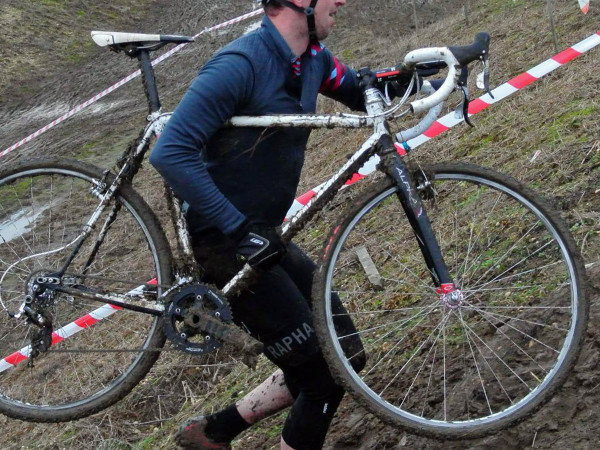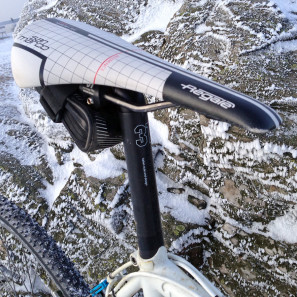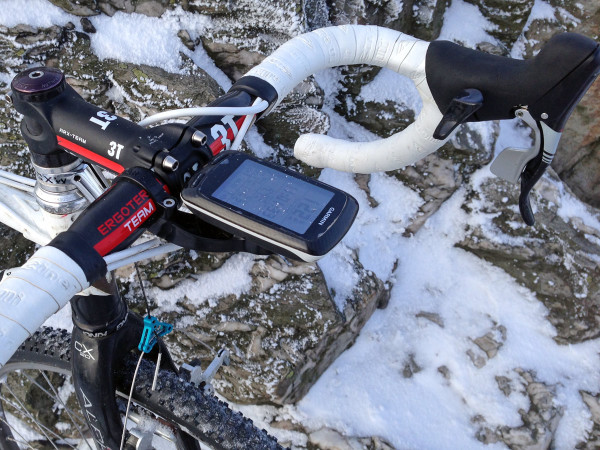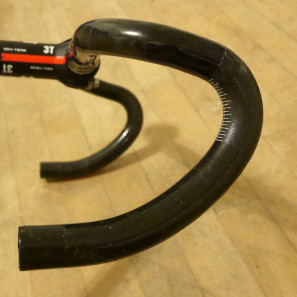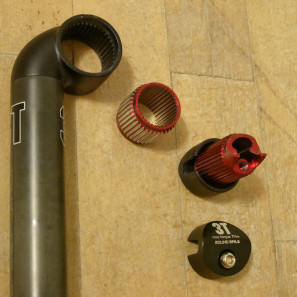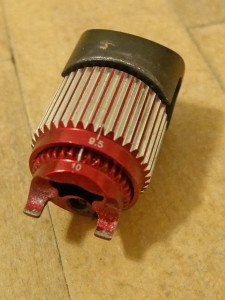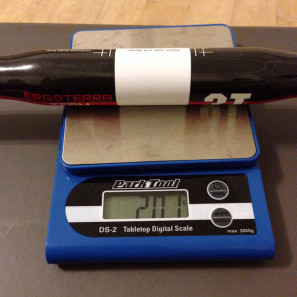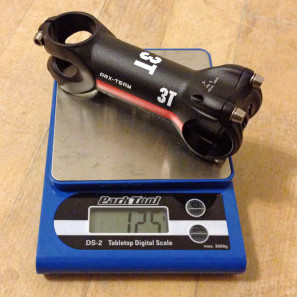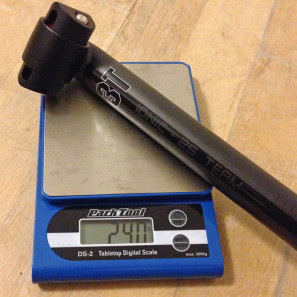We’ve passed the summer solstice and with each passing week the earlier sunsets are reminding us that cyclocross season is on the way once again. With that in mind, we are going to start to wrap up some long-term tests that have been in the works to get ready for a new cross season. We’ve got a few things that trickled in at the end of the last race season and others that spread to spring gravel and dirt riding and are helping us get back in shape for upcoming racing. One such kit that ticks all of those boxes is the mostly carbon Team cockpit from 3T that promises to stand up to the rigors of cross. We’ve put a bit different kit to the test on one of our project bikes, although that is more of a road setup.
The carbon Ergoterra handlebar, carbon Ionic seatpost, and aluminum ARX stem have seen some more aggressive testing on a couple of cross bikes and made it through their share of muddy and snowy crashes without being worse for the wear. Follow us past the jump to see what we thought of each piece, to get some real weights, and to think about this season’s cross builds…
Details and Ride Impressions
The carbon Ergoterra Team handlebar is designed specifically for cyclocross, and we tried to give it as much of a test of that as we could. It has a small amount of flare in the drops to give a wider more stable position for riding rougher terrain, with the idea of keeping the rider’s elbows out a bit more. Our bar is sized as a 45cm, which is what it measures from center-to-center at the ends of the bar. That corresponds to 42cm center-to-center where the hoods are mounted, making this a generally narrow bar at the hoods and wide at the drops. I kind of feel that this is a nice scenario for cross, where you can keep your frontal profile and shoulders narrow in tight riding, yet get wider in the drops for the more sketchy sections. The difference in width definitely favors a rider who is comfortable moving around on the bar though. If you only sit on the hoods or tops, you miss out on the benefit (and might think it too stiff, more on that in a second.) This bar is also available in a 47mm width (44 at the hoods), and both get a longish 89mm reach and a middle-of-the-road 128mm drop in a progressive ergonomic bend.
With the bar having a longer reach than most we test, I dropped 10mm off of the test bike’s standard length for a 100mm, 6° aluminum ARX Team stem. The stem is a pretty basic affair, forged from 7075 aluminum and held together with regular 4mm-head ti bolts. Its face gets a little 3T-shaped window that shows the white center section of the matching bar. We don’t have much to say about the stem, really. It did its job well and disappeared. It felt stiff enough, and we haven’t had any problem with it or its titanium bolts, even after taking it on and off bikes a few times. We do like this first generation of the ARX and it has some plusses and minuses over the newer ARX II. It keeps a wider faceplate for a little more stiffness and uses easy to use allen head bolts, instead of the torx T25s of the updated version, with only a reported 5g penalty.
The carbon/alu Ionic Team Stealth seatpost was the only of the three pieces that gave us any trouble, and that was just in setup. The post uses a carbon shaft bonded to an 25mm offset aluminum head. The clamp is 3T’s DiffLock coupler that uses 2 nested toothed interfaces to get fine angle adjustment once you figure out how to set it up. (No instructions for adjusting the angle are included, nor are they readily available on 3T’s website. But the main seat guts do get laser etched 9.5° and 10° markings to start from.) Essentially what works is the outer interface and inner interface have a different number of teeth and adjusting them separately you get up to 0.5° adjustability in a completely secure system. (The outer ring has 38 teeth so moving one step shifts 9.47°. The inner ring has 36 teeth for 10° per step. So move one in each direction to get a 0.5° step.) Getting it close to where you wanted felt like a luck of the draw, but once there it was simple enough to move one ring to the left and one to the right to move in half degree steps to where you wanted to end up. What is really nice was that fore-aft adjustment was independent and didn’t affect the angle. But to adjust the saddle angle during a ride you needed to loose both sides, smack it loose, then take the entire seat guts apart to move one step. Setting it up really took more patience than I like to spend, and with the number of times we end up swapping bikes and saddles, I would really only choose this post to get a matching 3T cockpit.
The 45cm Ergoterra Team bar is pretty light at 201g and retails for 290€/$325. Our 100mm ARX test stem weighed 125g (on the nose for the weight claimed for the next size up 110mm one) and sells for 90€/$100. The 27.2 x 350mm Ionic 25 was a little heavier than expected at 240g uncut, and you can easily feel that weight is in the head. It retails for 150€/$160.
Final Thoughts
We tested the cyclocross durability of the whole set, which essentially means that the parts got crashed in both mud and ice, and had their fair share of careless solo pit swaps (that is, quick bike changes mid-race without the luxury of a pit mechanic, which often ends with bikes dropped, only to be picked up after the race.) Typically cyclocross isn’t a good venue for a carbon bar, and we were a little reluctant at first. (We did break another company’s non-cross-specific carbon bar last season, and had to finish that race with one drop held on by only the bar tape.) But the bar made it through a half dozen cross races unscathed (and at least 3 wipe outs, although nothing high speed) before we unwrapped the bar to give it a look over. It then spent the spring and early summer mixed between riding dirty asphalt and dirt roads. The bar has a unmistakeable stiff feel to it. On the bike for an hour or less and it was never an issue, but on longer rides spending a lot of time on the hoods transferred a good bit of road/trail chatter into our arms. Moving into the drops lessened the shocks, but it seemed clear to us that by laying up carbon to survive cross racing the bars end up too stiff for our longer rough trail rides. The slight flare does work well for road riding too, though. We liked the narrower width of 42cm at the hoods, which kept us more aero for long stints crouched down in the wind, with the added stability of a wider bar in the drops. On the road a 43cm (40 at the hoods) option might even be nice?
Again the stem performed well and was on par with the competition for weight and stiffness. We’ll have no problem keeping it in the rotation to get our fit right on road and cross test bikes, and it seems like good value for the money.
As for the seatpost, the complicated adjustment of the head makes it a bit frustrating for us as we swap parts in and out a lot. It took longer than we would like to get the precise angle we wanted, and the process didn’t seem all that intuitive. Once you get it set though, the nature of the toothed head means it is 100% solid. It withstood all the rough cyclocross remounts we threw at it with no chance of slipping or any noise (something few seatposts can say.) The overall ride of the post was typical for a carbon post, with a bit of vibration dampening, but at 240g we’ve ridden plenty of lighter posts (even in aluminum) that match its performance. What is maybe most interesting is that 3T offers a Comfort variation of the post that puts a vibration dampening rubber ring around the head that should do even more to smooth out the ride. We had hoped to try that on out other project bike as well, but it wasn’t available. Maybe we’ll test one out in the future.
